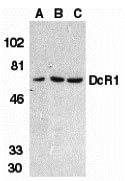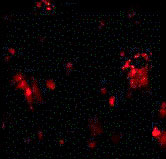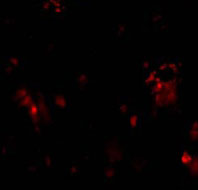DcR1 Antibody
- SPECIFICATION
- CITATIONS
- PROTOCOLS
- BACKGROUND

Application
| WB, IF, E |
|---|---|
| Primary Accession | O14798 |
| Other Accession | AF012536, 2338421 |
| Reactivity | Human, Mouse, Rat |
| Host | Rabbit |
| Clonality | Polyclonal |
| Isotype | IgG |
| Calculated MW | 65 kDa |
| Application Notes | DcR1 antibody can be used for detection of DcR1 by Western blot at 1 µg/mL. An approximate 65 kDa band can be detected. Antibody can also be used for immunoflourescence starting at 10 µg/mL. For immunofluorescence start at 20 µg/mL. |
| Gene ID | 8794 |
|---|---|
| Other Names | DcR1 Antibody: LIT, DCR1, TRID, CD263, TRAILR3, TRAIL-R3, DCR1-TNFR, LIT, UNQ321/PRO366, Tumor necrosis factor receptor superfamily member 10C, Decoy TRAIL receptor without death domain, DcR1, tumor necrosis factor receptor superfamily, member 10c, decoy without an intracellular domain |
| Target/Specificity | TNFRSF10C; |
| Reconstitution & Storage | DcR1 antibody can be stored at 4℃ for three months and -20℃, stable for up to one year. As with all antibodies care should be taken to avoid repeated freeze thaw cycles. Antibodies should not be exposed to prolonged high temperatures. |
| Precautions | DcR1 Antibody is for research use only and not for use in diagnostic or therapeutic procedures. |
| Name | TNFRSF10C |
|---|---|
| Synonyms | DCR1, LIT, TRAILR3, TRID |
| Function | Receptor for the cytotoxic ligand TRAIL. Lacks a cytoplasmic death domain and hence is not capable of inducing apoptosis. May protect cells against TRAIL mediated apoptosis by competing with TRAIL- R1 and R2 for binding to the ligand. |
| Cellular Location | Cell membrane; Lipid-anchor, GPI-anchor. |
| Tissue Location | Higher expression in normal tissues than in tumor cell lines. Highly expressed in peripheral blood lymphocytes, spleen, skeletal muscle, placenta, lung and heart |

Thousands of laboratories across the world have published research that depended on the performance of antibodies from Abcepta to advance their research. Check out links to articles that cite our products in major peer-reviewed journals, organized by research category.
info@abcepta.com, and receive a free "I Love Antibodies" mug.
Provided below are standard protocols that you may find useful for product applications.
Background
DcR1 Antibody: Apoptosis is induced by certain cytokines including TNF and Fas ligand in the TNF family through their death domain containing receptors. TRAIL/Apo2L is a new member of the TNF family and induces apoptosis of a variety of tumor cell lines. DR4 and DR5 are the recently identified functional receptors for TRAIL. Two decoy receptors for TRAIL have been identified and designated DcR1/TRID/TRAIL-R3/LIT and DcR2/TRAIL-R4/TRUNDD. DcR1 has extracellular TRAIL-binding domain but lacks intracellular signaling domain. It is a glycophospholipid-anchored cell surface protein. DcR1 transcripts are expressed in many normal human tissues but not in most cancer cell lines. Overexpression of DcR1 did not induce apoptosis, but attenuated TRAIL-induced apoptosis.
References
Pan G; O'Rourke K; Chinnaiyan et al.. The receptor for the cytotoxic ligand TRAIL. Science; 1997;276:111-113
Pan G, Ni J, Wei YF, et al. An antagonist decoy receptor and a death domain-containing receptor for TRAIL. Science 1997;277:815-8
Sheridan JP, Marsters SA, Pitti RM, et al. A. Control of TRAIL-induced apoptosis by a family of signaling and decoy receptors. Science 1997;277:818-21
Degli-Esposti MA, Smolak PJ, Walczak H, et al, Smith CA. Cloning and characterization of TRAIL-R3, a novel member of the emerging TRAIL receptor family. J Exp Med 1997;186(7):1165-70
If you have used an Abcepta product and would like to share how it has performed, please click on the "Submit Review" button and provide the requested information. Our staff will examine and post your review and contact you if needed.
If you have any additional inquiries please email technical services at tech@abcepta.com.













 Foundational characteristics of cancer include proliferation, angiogenesis, migration, evasion of apoptosis, and cellular immortality. Find key markers for these cellular processes and antibodies to detect them.
Foundational characteristics of cancer include proliferation, angiogenesis, migration, evasion of apoptosis, and cellular immortality. Find key markers for these cellular processes and antibodies to detect them. The SUMOplot™ Analysis Program predicts and scores sumoylation sites in your protein. SUMOylation is a post-translational modification involved in various cellular processes, such as nuclear-cytosolic transport, transcriptional regulation, apoptosis, protein stability, response to stress, and progression through the cell cycle.
The SUMOplot™ Analysis Program predicts and scores sumoylation sites in your protein. SUMOylation is a post-translational modification involved in various cellular processes, such as nuclear-cytosolic transport, transcriptional regulation, apoptosis, protein stability, response to stress, and progression through the cell cycle. The Autophagy Receptor Motif Plotter predicts and scores autophagy receptor binding sites in your protein. Identifying proteins connected to this pathway is critical to understanding the role of autophagy in physiological as well as pathological processes such as development, differentiation, neurodegenerative diseases, stress, infection, and cancer.
The Autophagy Receptor Motif Plotter predicts and scores autophagy receptor binding sites in your protein. Identifying proteins connected to this pathway is critical to understanding the role of autophagy in physiological as well as pathological processes such as development, differentiation, neurodegenerative diseases, stress, infection, and cancer.




